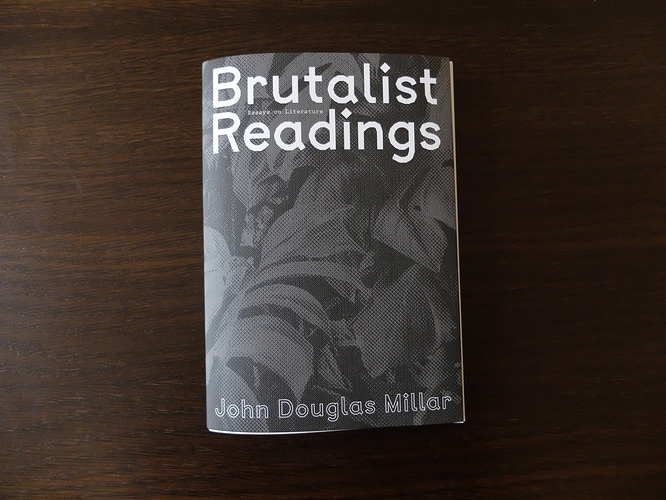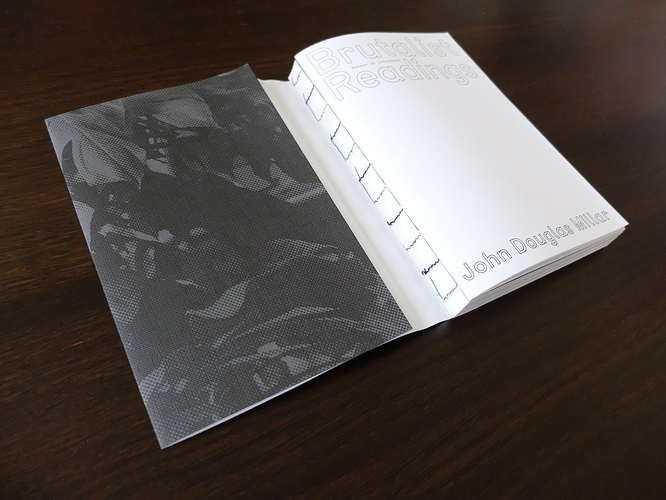Editor’s note: Published in May 2016, John Douglas Millar’s “Brutalist Readings: Essays on Literature” examines writing in the context of contemporary art, and its ability to respond to our most pressing issues: the debt economy, global violence, and a redefinition of identity politics, among them. In this important volume, Millar considers how to proceed after a paradigm shift away from the dusty halls of October-generation critique. In collaboration with Sternberg Press, e-flux conversations is pleased to excerpt “Cages in Search of Birds,” the introduction to the second part of Millar’s “Brutalist Readings,” with responses from Kathryn Elkin, Nick Thurston, and McKenzie Wark.
Cages in Search of Birds
I understand the fatigue that many feel with the negativity of critique, its presumption of authority, its shear out-of-dateness in a world that couldn’t-care-less, but it still beats the shallowness of flip opinion and the passivity of cynical reason, not to mention the other options on offer. (In lieu of criticality comes what exactly? – beauty? affect? celebration? any other pills to pop?) […] There are no alternatives without critique.
-Hal Foster, The Art-Architecture Complex
What must be avoided like the plague is rehearsing the summary of the contents.
-Walter Benjamin, Programme for Literary Criticism
However much they might deny it, the aging males of the cultural left – Benjamin Buchloh, T.J Clark, Hal Foster et al. – believe the game is up and that it has been for some time, effectively since the Soviet Union collapsed a quarter century ago. The great universal, History with a capital ‘H’, exited stage Left and they were marooned on the beach of an eternal present, staring bitterly upon a sea of neon particularities that could surely never be made to coalesce. In the cultural sphere, art and finance moved from uncomfortable symbiosis to absolute fusion and the critical project withered on the vine, poisoned by the virus of shear contingency. When history returned, blasting into the towers of the World Trade Center, it was in the form of a rabid theologization of politics and in a state of perpetual emergency. Those critics who had an investment in the antinomic writings of the Frankfurt School had little to offer other than the continued affirmation of negation, albeit in texts of elegant despair. T.J Clark in his piece A Left With No Future, tonally the exemplar of this autumnal criticism, writes: “[A] previous language and set of presuppositions for emancipation have run into the sand [and it is uncertain] whether the elements of a different language are to be found at all in the general spectacle of frozen politics, ruthless economy, and enthusiasm (as always) for the latest dim gadget.” “Is this pessimism? Well, yes.” While Benjamin Buchloh wallows in the sweet annihilation of the drowning as he considers the awesome totality of capital:
The very objects, goods and strategies that had promised the utopian transformation of bourgeois society […] now return to its recipients as an immense arsenal of heretofore unimaginable forms of domination in the construction of a society of total control, consumption and spectacularization. Every act of a once supposedly emancipatory and liberating reduction of skills, every gesture of easy gratification seemingly liberated from the necessities of labor, drives the subject into states of ever-deeper dependence and domination.
It is easy, though nonetheless necessary, to criticize Clark, Buchloh and the rest for their cultural myopia, their uncritically assumed authority and their failure to look beyond the modernist canon, the faculty dinner and the biannual greenroom for a frame of reference. It can be tempting to leave them on their melancholy island, once faithful statesmen exiled to the edges of the empire, we might run them a bath and pass them the knife, place Le Marteau sans Maître on the phonograph to see them off.
But hold the blade.
For as much as their recent attempts to grab onto a Hirschhorn, or a Farocki, a Sekula or a Sehgal in order to keep themselves afloat on the sea of contemporaneity might seem anachronistic and characteristically out of touch, there are elements of their diagnoses of the cultural and political present that are sometimes necessarily bracing. I write this at the end of a summer during which the incommensurable precarity and violence of our current situation has been revealed in shocking relief. From the baleful disappointments of the Greek situation for anyone who glimpsed in Syriza’s brief defiance the match-strike of a different Europe, through the multifarious and spiralling conflicts in North Africa and the Middle East and the attendant refugee crises, to the Conservative government’s mendacity on the domestic front, these are leaden times. The questions that inevitably arise for anyone making art, or writing about it, or showing it in such circumstances are difficult ones. Should one take up a Sartrean engagé position? Reaffirm or mourn the passing of art’s autonomy and the potential for form to be raised to the level of social critique à la Buchloh? Forget autonomy and demand propaganda like Boris Groys? Call for a new and vaunting prometheanism with the apostles of Nick Land? Join the protestant wing of the anthropocene creeders and accept that we are already dead (and don’t we deserve it)? Forget about it all amongst the rhizomatic coils of online life? Take up yoga? Where should one turn for ballast and justification?
A brief book of literary essays such as this carries a disproportionate cargo of vanity with it, and speaks to, at best, a microscopic audience. One is hesitant to push vanity towards absurdity by making any inflated claims on behalf of it. As Foster writes: “Today the social bond is as pressured as the public sphere is atrophied, and criteria more robust than discursivity and sociability are required in response.” Equally though one does not want to give in to despair or accept critical and creative impotence in the face of the seemingly crushing actuality of the present.
Nonetheless one must remain wary. Hal Foster is right that all too often the world of contemporary culture does not produce a “robust pluralism” so much as a “debilitating relativism.” Critical pluralism, if it is to mean anything, must be founded on the recognition that, as Brian Dillon says, we cannot all be friends all of the time. Pluralism demands agonism, but this returns us to the fiction of the public. With an atrophied public sphere where is this agonism to be enacted and where is it to gain traction? For now as far as culture is concerned the only candid answer one can give is within small-scale and clandestine communities that are able to make occasional funding forays into the institutional sphere while retaining and maintaining the specific characteristics of their ecologies; communities whose relation to the ‘art world’ must be necessarily parasitic and fugitive, similar to the relation to the university described by Stefano Harvey and Fred Moten: “To abuse its hospitality, to spite its mission, to join its refugee colony, its gypsy encampment, to be in but not of—this is the path of the subversive intellectual.”. Such communities and their art making are invisible to critics like Foster, Clark and Buchloh, whose gazes remain trained on the programmes of major public institutions and the exhausted masculine politics of the old Left.
Over the last decade or so vanguard species of filmmaking, choreography and writing that would once have found a semblance of support within the institutional structures of their parent discipline (cinema, dance, and literature respectively) have looked to the contemporary art world for financial support and in order to re-establish critical ecologies that have waned elsewhere. In the cases of dance and film particularly this has been a two-way relationship. It has suited the economic and ideological rationales of the large art institutions to present what are comparatively cheap events in terms of staging that speak to the contemporary penchant for relational, time-based and participatory work. When they have approached these forms of art making at all, the critics of the October generation have been dismissive, in the case of the forms of writing that have found succour within the art world they have ignored them all together.
If part one of this book engaged conceptual writing as a form of art making that has sought to situate itself in relation to the long critical histories that have preoccupied the October generation and their peers by bringing the strategies of conceptualism to bear upon the straw man of the institution of literature and by embracing an avant-gardist cultural logic, then part two looks to find examples of writing that have been received primarily within the context of the contemporary art world and that complicate those histories by making visible communities, theories and modes of writing that have been, to some degree, suppressed within them. The monographic essays in part two are born of what Jacqueline Rose describes as a “fragile, determined urgency.” Certainly they value urgency over elegance. These are pieces that were written in the excitement of an encounter and they consider works that, as Karl Smith puts it use “the “I” as a weapon to explore its own fragility.” As such they relinquish some of the academic qualification of part one. These essays consider works that have brought me pleasure and pleasure requires less qualification than disaffection.
In a sense part two of this book seeks to engage Foster’s question: In lieu of criticality what exactly? With the answer, why not criticality with beauty, with affect, with celebration and a whole host of other uppers, downers, screamers, laughers? Why not a criticism that, for one, does not deny the body? Not it’s cells, nerves and neurons, nor the affects and emotions that traverse them. A criticism that, as I write of one of the works herein, reveals the fact that theory (and criticism), emerge out of the messy stuff of actually lived lives; a form of immanent and embodied critique then, or to push the Hunter S. Thompson thing, gonzocritique. Criticism that accepts experience as a legitimate subject for analysis, that, as Ben Lerner puts it, “inhabits the contradictions and possibilities of [one’s] position in the world” while rejecting feeling by itself as a basis for art making, political action or anything else. (At the macro-political level the valorisation of feeling leads to the spectacle of Tony Blair claiming ‘belief’ as a legitimate reason for war waging). If the following affirms anything then it is that, as Lerner says, “there are moments in our life and in our experience that are not totally corrupt – they’re not pure, but they’re not totally corrupt”. And that: “Immanence is a way of thinking about how redemption [is] always immanent with an ‘a’, even if you don’t feel it’s imminent with an ‘i’. If we’re not going to simply despair, we have to be alive to the possibilities of the present.” It was with the firm belief that new resources are needed for accessing, opening up, and extending those possibilities that the following pieces were written.

